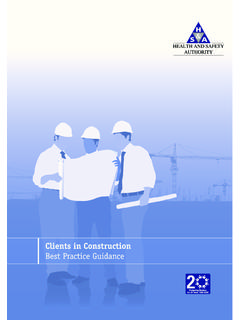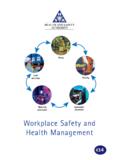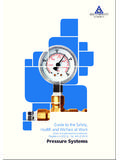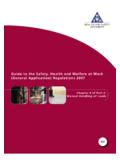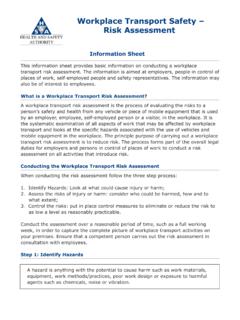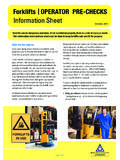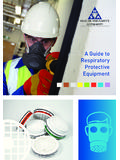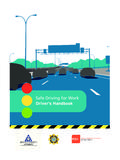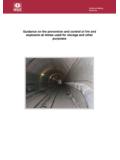Transcription of Local Exhaust Ventilation (LEV) Guidance
1 Local Exhaust Ventilation (LEV) GuidanceOur vision: A country where worker safety, health and welfare and the safe management of chemicals are central to successful enterprisePublished in January 2014 by the Health & Safety Authority, The Metropolitan Building, James Joyce St., Dublin 1 Summary ..2 Chapter 2 Introduction ..4 Risk Assessment ..5 control ..5 Chapter 3 What is Local Exhaust Ventilation (LEV )? ..7 Chapter 4 Types of Local Exhaust Ventilation (LEV ) ..19 Chapter 5 Misconceptions ..31 Chapter 6 Properties of Airborne Contaminants ..35 Chapter 7 Flow Rates ..38 Chapter 8 How to Select Local Exhaust Ventilation (LEV ) ..40 Chapter 9 Installation and Maintenance of LEV ..43 Chapter 10 Information and Training for Employees ..47 Chapter 11 Keeping Records ..49 Chapter 12 Examining & Monitoring Performance ..50 Chapter 13 Main Legal Requirements ..57 Chapter 14 Standards ..61 Chapter 15 References.
2 62 Chapter 16 Further Reading ..63 Chapter 17 Useful Contacts ..64 Chapter 18 Glossary ..65 Drawings/pictures/diagrams courtesy of the HSE/HSL UK & IOSH2 Chapter 1 This Guidance is written for employers, managers, employees and their safety representatives and those who provide, install and maintain Local Exhaust Ventilation (LEV) systems. In preventing exposure to harmful substances in the workplace, there is a hierarchy of control measures that must be considered, commencing with the elimination or substitution of the hazard or, where these options are not possible, the hazard must be controlled by engineering means. Local Exhaust Ventilation (LEV) is one such engineering control is an engineering system designed to reduce employee exposure to airborne contaminants (dust, mist, fume, vapour, gas) in the workplace by capturing the emission at source and transporting it to a safe emission point or to a filter/scrubber. Employers need to work with designers, suppliers, installers and employees to effectively control exposure to airborne contaminants.
3 Suppliers must provide LEV that is fit for purpose, is shown to work and continues to employer (the LEV owner) must ensure controls are adequate. Everyone, including suppliers and users of the LEV, must be competent in the use of the LEV main LEV elements are: A hood of some kind, where the contaminants enter the system Ducting, which safely transports the contaminants to a filter/cleaner/ Exhaust point Air cleaner/filter/scrubber Air mover: a fan to power the system Discharge: a safe point of air exhaustWhen using LEV to control exposure, the employer must thoroughly assess the hazards to be controlled and be satisfied with the following: the LEV system is fit for purpose; it is being used correctly by trained employees; the system is regularly maintained to remain effective; and records are kept to demonstrate the system is both effective and ongoing. Having a good understanding of what hazards need to be controlled is crucial to ensure that the initial design is capable of achieving adequate 100%Magenta 76%Yellow 0 Black 27% Local Exhaust Ventilation (LEV) GuidanceChapter 1 SummaryWhen installing LEV.
4 Identify and assess the hazard(s) to be controlled Identify competent contractors to install the system Provide the installer with clear requirements or specifications Review and ensure that the design and its specifications are satisfactory Obtain and retain all the related paperwork in design specifications, including the commissioning report (hand book) Ensure when the system is installed that it meets the design specifications Maintain the system and measure performance regularly Train employees in the proper use of the LEV3 Chapter 1 Cyan 100%Magenta 76%Yellow 0 Black 27% Local Exhaust Ventilation (LEV) GuidanceChapter 2 IntroductionLocal Exhaust Ventilation (LEV) is an engineering system frequently used in the workplace to protect employees from hazardous substances. To have an effective system it is important that it is well designed and installed, used correctly and properly maintained. All the participants, from designer to end-user need to work together to provide an effective Problems Employers are often unaware their employees are being over-exposed to hazardous substances or that existing controls may be inadequate Sources of exposure are missed Employers (and suppliers) are over-optimistic about the effectiveness of the controls Existing controls have deteriorated Controls are not used correctlyEmployers need to work with designers, suppliers and employees to ensure effective control , to avoid expensive mistakes and to control exposure effectively.
5 Suppliers must provide LEV that is fit for purpose, is shown to work and continues to work. The employer (the LEV owner) must ensure controls are adequate. Everyone, both suppliers and users of the LEV, must be competent in the operation of the LEV health effects can occur when employees are exposed to occupational hazards such as dusts, fumes and vapours (chemical or biological agents). The effects of exposure to a hazard depend on the frequency, duration and degree of exposure: some substances can cause immediate health effects, such as carbon monoxide poisoning; others, such as asbestos, can have a long latency period. The potential for exposure to any chemical or biological agent needs to be assessed in each place of work. Employees can contract occupational illnesses and diseases and develop these because they breathe in too much dust, fumes or other airborne contaminants at work, often because control measures are not in place or do not work well enough. Many industries can be affected, including chemical processing, pharmaceutical, biotechnology, woodworking, welding, paint-spraying, stonemasonry, engineering and foundry work.
6 The purpose of this Guidance is to describe how to control gas, vapour, dust, fume, mist, in other words aerosols (hazardous agents), in the workplace air by using Local Exhaust Ventilation (LEV), extracting the contaminant and preventing exposure. Cyan 100%Magenta 76%Yellow 0 Black 27% Local Exhaust Ventilation (LEV) Guidance4 Chapter 2 Although this guide concentrates on Local Exhaust Ventilation (LEV), it is important to remember that the control or lack of general Ventilation , including general supply and Exhaust Ventilation , can affect the performance of the LEV. For instance, a draught from an open door may challenge a welding hood extraction performance, or an insufficient supply of air in a closed system will starve an exhausting LEV system. Therefore there are many factors that need to be considered when installing AssessmentA risk assessment involves (1) anticipating; (2) recognising; (3) evaluating; and (4) controlling the hazards to which the employee might be exposed.
7 The Authority has advice on its website ( ) on how to carry out an the employer has completed a risk assessment, evaluated the risks and determined the potential hazards, control methods need to be considered. As well as health hazards, there may be flammability, reactivity and/or physical hazards ( excessive heat). ControlWhen control is being considered there is a standard hierarchical approach. Can the process be changed so that the hazardous chemical agent can be eliminated or substituted with a less hazardous one? Can the process be modified to reduce risk of exposure (for example can the process temperature be lowered to reduce vapour release)? Are engineering controls appropriate? Can structures such as hoods, booths, enclosures or Local Exhaust Ventilation be used to contain or capture hazardous chemical agent emissions? Administrative controls are used to minimise employee exposure by time planning and rotation. The final control in the hierarchy is the use of personal protective equipment (PPE).
8 Cyan 100%Magenta 76%Yellow 0 Black 27% Local Exhaust Ventilation (LEV) Guidance5 Chapter 2In installing controls, the employer should start at the top of the hierarchy before rushing to install Local Exhaust Ventilation (LEV), for example. The employer must first determine what is the most effective controls measure(s). The installation of any control measure is likely to be expensive (it has, for example, the potential to introduce operational difficulties), so a thorough review of the effectiveness of the chosen control method and how employees will interface with the system is LEV system must be fit for purpose. For example, where the process entails grinding, it is likely that dust will be propelled from the source and the system needs to be designed to contain and capture the fugitive dust. Before designing or installing an LEV system, a good understanding of contaminants and the process demands are necessary. Consideration should be given as to whether the system will be required to cope with changing materials processes and, if so, whether you need to build in flexibility for this from the installation of new engineering controls such as LEV may bring its own risks and should be included in the overall assessment of operations.
9 How well does the LEV system interface with the employee, the process and the place of work? For example, the noise generated by new fans/motors may need to be considered to prevent over-exposure to noise in the workplace; manual handling or ergonomic difficulties may be introduced; it may result in the generation of static electricity because of material type; or lack of bonding/earthing may be an ignition the system is installed as designed, it must be used correctly and not tampered with; it must be regularly performance checked so that its effectiveness in protecting the employee(s) is achieved and must be maintained as laid down in the risk some circumstances, such as woodworking machines, the LEV may be designed as an integral part of the equipment. Therefore, although the design stage is completed in advance, employee training must be applied in all other elements, such as proper use, cleaning and 100%Magenta 76%Yellow 0 Black 27% Local Exhaust Ventilation (LEV) Guidance6 Chapter 2 Chapter 3 What is Local Exhaust Ventilation (LEV)?
10 In its simplest terms Local Exhaust Ventilation is an engineering system to protect employees from exposure to hazardous substances by containing or capturing them locally, at the emission point. Local Exhaust Ventilation (LEV) is only one of many engineering control options that may be used to remove and prevent employee exposure to vapour, mist, dust or other airborne contaminants. To be effective in protecting the employee(s), it is important that it is of good design, is fit for purpose, is regularly maintained and the system s performance is monitored. Failure to do so can lead to employees being exposed because they have the impression that the system is effective when it is not. Poor design and/or maintenance may lead, for example, to leakage in the workplace, causing concentrated Local exposure rather than preventing it. A poorly designed, installed, misused and incorrectly maintained system can become an expensive waste of expenditure and may give a false impression of hazard must be given training in its use and maintenance to understand its correct use and effectiveness.
